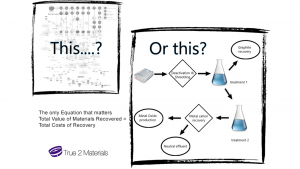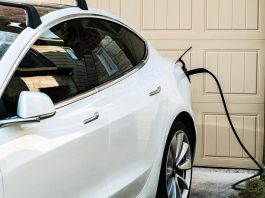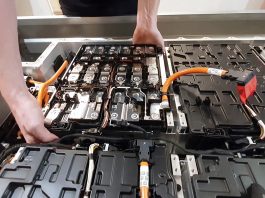True 2 Materials has developed a novel battery recycling process known as Total Material Recovery (TMR). TMR is entirely outside the borders of both the contemporary recycling techniques operating commercially today, and the known theoretical techniques, which are in development in laboratories around the globe.
Recovering cathodes as sulphates and anodes as damaged carbon is not the answer. Recovering battery-grade, usable anodes and cathodes (oxides) wins across all metrics.
EV battery recycling methods
The worldwide search for a solution to enable us to directly recycle the used cathodes and anodes of electric vehicle (EV) batteries back into new cells, with minimal processing, has been a long one. Today, the only methods of recycling both end-of-life batteries, and manufacturing scrap – which currently makes up almost all of the feedstock available – at scale, are pyrometallurgy (burning) or hydrometallurgy (acids) or some combination of the two.
Greatly simplified, today batteries are shredded, burned, or dissolved, and then the valuable outputs are extracted one by one from the ‘black mass’ remaining.
Despite the claims of cutting-edge technique and investment-worthy uniqueness by modern recyclers, at their core these methods all have basically the same process charts, weaknesses, and inability to be improved much outside the margins. No matter how favourably you parse things, contemporary battery recycling methods:
- Get their valuable outputs back as sulphates;
- Only extract these outputs one at a time, thereby needing a long complex series of pipes and tanks;
- Destroy many of the valuable components of these cells during processing, including the spherical graphite of the anode;
- Are unable to profitably process cells with cathode mixtures, such as lithium iron phosphate battery (LFP), that have low-cost metals as their inputs; and
- Are cost centres for all involved, apart from those accepting the fees for what is basically waste clean-up rather than recycling. Without subsidies and a massive increase in volume, they all lose money.
Possible mooted direct recycling techniques are either inefficient if they scale, or will not scale if they are efficient.
What is Total Material Recovery?
TMR is not a wrinkle on acids or fire, it does not involve floating portions of valuable materials out of the black mass or some science-fiction-like work with microbes, plants, or fungi. It is not a modified mining technique. There are no high temperatures, no huge electrical currents, no powerful solvents, or harmful emissions. Our effluents are neutral, and our temperatures are mild. We recycle the cells by passing them through a rough shred, and then basically separate everything in the mass from everything else in a couple of steps, recovering the spherical graphite as is, and all the metals as oxides.
The spherical graphite can be returned directly to a cell for reuse. Our cathode material can either be re-lithinated and reused with no further processing, or put onto outside markets as oxides.
We feel, simply put, that the battery recycling methods being utilised today are severely sub-optimal.
Hubs and spokes? Why do all that shipping? Spherical graphite costs thousands of dollars per tonne and is a strategic material. Is reducing it to carbon black or burning it the best we can do? What is the plan for low-cobalt battery chemistries like LFP? Reagents and consumables are around 35% of the operating expense (OpEx) for a hydrometallurgical plant. Acids are expensive.
Additionally, the Environmental Protection Agency (EPA) forecasts a 100 million tonne per annum shortfall in sulphur by 2040, as most of the world’s supply comes from purifying sour crude oil. Less crude oil, less sulphur. Less sulphur, less sulphuric acid, meaning higher OpEx costs. If the outputs are sulphates, there will be huge amounts of sulphur oxide (SOx) emissions that someone in the chain is responsible for. In addition, one third of the greenhouse gas emissions in creating an EV cell are released turning sulphate metals into active cathode materials, and flake graphite into spherical graphite. Let’s avoid those. You claim to get 90%+ of the valuable materials back? Without being facetious, why not 100%?
TMR renders all of these questions moot. True 2 Material’s top client is the environment, but we also realise that rules and regulations are easily trumped by simple economics. TMR wins on all metrics. The recycling process is elegant and clean, but most of all, inexpensive. Decarbonisation of your operation is a lot easier to do when it can become a significant profit centre instead of a loss. We are currently at Technology Readiness Level 5-6 and are ready to industrialise our process. We are looking for a keystone partner to help us towards this goal. Contact us if you wish to test our claims.
Please note, this article will also appear in the twelfth edition of our quarterly publication.










